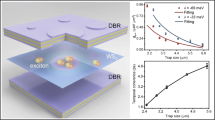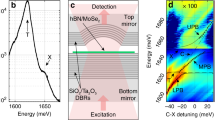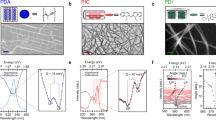Abstract
The increasing ability to control light–matter interactions at the nanometre scale has improved the performance of semiconductor lasers in the past decade. The ultimate optimization is realized in semiconductor microcavities, in which strong coupling between quantum-well excitons and cavity photons gives rise to hybrid half-light/half-matter polariton quasiparticles1. The unique properties of polaritons—such as stimulated scattering2,3, parametric amplification4,5,6, lasing7,8,9,10, condensation11,12,13 and superfluidity14,15—are believed to provide the basis for a new generation of polariton emitters and semiconductor lasers. Until now, polariton lasing and nonlinearities have only been demonstrated in optical experiments, which have shown the potential to reduce lasing thresholds by two orders of magnitude compared to conventional semiconductor lasers16. Here we report an experimental realization of an electrically pumped semiconductor polariton light-emitting device, which emits directly from polariton states at a temperature of 235 K. Polariton electroluminescence data reveal characteristic anticrossing between exciton and cavity modes, a clear signature of the strong coupling regime. These findings represent a substantial step towards the realization of ultra-efficient polaritonic devices with unprecedented characteristics.
This is a preview of subscription content, access via your institution
Access options




Similar content being viewed by others
References
Weisbuch, C., Nishioka, M., Ishikawa, A. & Arakawa, Y. Observation of the coupled exciton-photon mode splitting in a semiconductor quantum microcavity. Phys. Rev. Lett. 69, 3314–3317 (1992)
Dang, L. S., Heger, D., André, R., Bœuf, F. & Romestain, R. Stimulation of polariton photoluminescence in semiconductor microcavity. Phys. Rev. Lett. 81, 3920–3923 (1998)
Senellart, P., Bloch, J., Sermage, B. & Marzin, J. Y. Microcavity polariton depopulation as evidence for stimulated scattering. Phys. Rev. B 62, R16263–R16266 (2000)
Savvidis, P. G. et al. Angle-resonant stimulated polariton amplifier. Phys. Rev. Lett. 84, 1547–1550 (2000)
Ciuti, C., Schwendimann, P., Deveaud, B. & Quattropani, A. Theory of the angle-resonant polariton amplifier. Phys. Rev. B 62, R4825–R4828 (2000)
Saba, M. et al. High-temperature ultrafast polariton parametric amplification in semiconductor microcavities. Nature 414, 731–735 (2001)
Porras, D., Ciuti, C., Baumberg, J. J. & Tejedor, C. Polariton dynamics and Bose-Einstein condensation in semiconductor microcavities. Phys. Rev. B 66, 085304 (2002)
Malpuech, G., Di Carlo, A. & Kavokin, A. Room-temperature polariton lasers based GaN microcavities. Appl. Phys. Lett. 81, 412–414 (2002)
Kasprzak, J. et al. Bose–Einstein condensation of exciton polaritons. Nature 443, 409–414 (2006)
Christopoulos, S. et al. Room-temperature polariton lasing in semiconductor microcavities. Phys. Rev. Lett. 98, 126405 (2007)
Deng, H. et al. Quantum degenerate exciton-polaritons in thermal equilibrium. Phys. Rev. Lett. 97, 146402 (2006)
Butov, L. A polariton laser. Nature 447, 540–541 (2007)
Balili, R., Hartwell, V., Snoke, D., Pfeiffer, L. & West, K. Bose-Einstein condensation of microcavity polaritons in a trap. Science 316, 1007–1010 (2007)
Carussotto, I. & Ciuti, C. Probing microcavity polariton superfluidity through resonant Rayleigh scattering. Phys. Rev. Lett. 93, 166401 (2004)
Kavokin, A., Malpuech, G. & Laussy, F. P. Polariton laser and polariton superfluidity in microcavities. Phys. Lett. A 306, 187–199 (2003)
Deng, H., Weihs, G., Snoke, D., Bloch, J. & Yamamoto, Y. Polariton lasing vs. photon lasing in a semiconductor microcavity. Proc. Natl Acad. Sci. USA 100, 15318–15323 (2003)
Imamoglu, A., Ram, R. J., Pau, S. & Yamamoto, Y. Nonequilibrium condensates and lasers without inversion: Exciton-polariton lasers. Phys. Rev. A 53, 4250–4253 (1996)
Carlin, J. F. et al. Design and characterization of top-emitting microcavity light-emitting diodes. Semicond. Sci. Technol. 15, 145–154 (2000)
Tischler, J. R., Bradley, M. S., Bulovic, V., Song, J. H. & Nurmikko, A. Strong coupling in a microcavity LED. Phys. Rev. Lett. 95, 036401 (2005)
Sapienza, L. et al. Photovoltaic probe of cavity polaritons in a quantum cascade structure. Appl. Phys. Lett. 90, 201101 (2007)
Sapienza, L. et al. Electrically injected cavity polaritons. Phys. Rev. Lett. 100, 136806 (2008)
Tartakovskii, A. I. et al. Relaxation bottleneck and its suppression in semiconductor microcavities. Phys. Rev. B 62, R2283–R2286 (2000)
Bajoni, D. et al. Polariton light-emitting diode in a GaAs-based microcavity. Phys. Rev. B 77, 113303 (2008)
Khalifa, A. A., Love, A. P. D., Krizhanovskii, D. N., Skolnick, M. S. & Roberts, J. S. Electroluminescence emission from polariton states in GaAs-based semiconductor microcavities. Appl. Phys. Lett. 92, 061107 (2008)
Acknowledgements
Support by the PENED projects 03EΔ841 and 03EΔ816 (funded 25% by national funds and 75% by EC) acknowledged.
Author information
Authors and Affiliations
Corresponding author
Rights and permissions
About this article
Cite this article
Tsintzos, S., Pelekanos, N., Konstantinidis, G. et al. A GaAs polariton light-emitting diode operating near room temperature. Nature 453, 372–375 (2008). https://doi.org/10.1038/nature06979
Received:
Accepted:
Issue Date:
DOI: https://doi.org/10.1038/nature06979
This article is cited by
-
Bright and stable near-infrared lead-free perovskite light-emitting diodes
Nature Photonics (2024)
-
Highly efficient polaritonic light-emitting diodes with angle-independent narrowband emission
Nature Photonics (2023)
-
Single-particle properties of topological Wannier excitons in bismuth chalcogenide nanosheets
Scientific Reports (2023)
-
Polariton condensates for classical and quantum computing
Nature Reviews Physics (2022)
-
A room-temperature polariton light-emitting diode based on monolayer WS2
Nature Nanotechnology (2019)
Comments
By submitting a comment you agree to abide by our Terms and Community Guidelines. If you find something abusive or that does not comply with our terms or guidelines please flag it as inappropriate.



